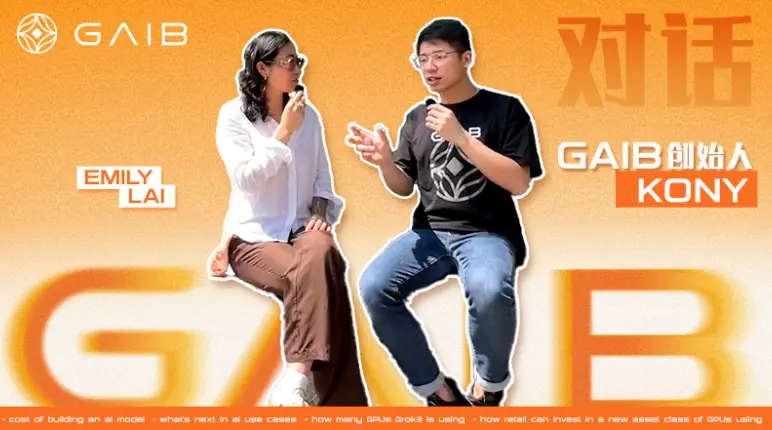Interviewer: Emily Lai
2024 is the year AI enters the mainstream, and "computing power" has become one of the key terms that attracts the attention of retail investors for the first time.
Behind this intelligent revolution, GAIB has chosen to enter the AI industry at its most fundamental level—GPU (Graphics Processing Unit), hoping to transform it into a new type of asset through on-chain financial mechanisms.
In this trend where technology and capital intersect, GAIB's founder and CEO Kony has his own set of ideas.
This is not a story about speculation, but a startup vision about "new assets, new currencies, and new capital structures."

"Computing power is the hard currency of the AI world"
Emily: Can you introduce GAIB in one sentence?
Kony: We turn GPUs into assets and break down AI into an independent investment track. GAIB is building an on-chain economic infrastructure for AI and computing power.
Emily: What is your view on computing power?
Kony: It is the energy of AI, essentially like electricity. You can think of data as fuel, models as engines, but what drives everything is computing power. If Bitcoin is digital gold, then GPUs are the power plants of the digital age.
Emily: As a user of AI applications, I often use tools like Midjourney, Canva's AI, Claude AI, etc. These AI models indeed require a lot of computing power during training, right?
Kony: Exactly. The process from training to inference of AI models is extremely reliant on GPUs. For example, Grok3 deployed on X used 100,000 H100s, worth over $2.5 billion. OpenAI, Anthropic, and Tesla's robotics division—without computing power, everything goes to zero.
"The AI economy is a smile curve, and GAIB aims to rewrite its left half"
Emily: What is the opportunity behind GAIB entering this field?
Kony: You can think of the entire AI industry as a "smile curve": the right side is To C applications, like Midjourney; the left side is AI infrastructure, like cloud/data centers. But the problem on the left side is the limitations of financing methods.
Data centers and cloud service providers need to procure a large number of GPUs, but their financing methods are limited to equity, bank loans, etc., which are very inefficient. We want to provide a new path: allowing them to assetize GPUs on-chain and release liquidity.
Emily: This sounds like a kind of "on-chain cloud bond"?
Kony: It's closer to "computing power asset tokenization." We are not issuing bonds; we are transforming the GPUs themselves into user-configurable on-chain assets. We want them to become tradable commodities like gold and oil.
"AID – The exclusive currency of the AI computing economy"
Emily: How does GAIB enable users to participate in the AI economy?
Kony: Our product is called AID (AI Dollar), which is the first AI synthetic asset. You can think of it as the "USDT" of the AI economy. Users can deposit stablecoins (like USDT), and GAIB will lend this portion of assets to cloud/data centers, which are GPU asset holders and operators, generating real cash flow returns.
As an AID holder, you can share in this portion of the returns. What we aim to do is not "issue tokens for speculation," but to establish an AI capital economy with real rental income.
Emily: Where does the income come from?
Kony: The income comes from the real demand for GPU usage—AI companies pay for computing power, which is the most genuine and robust cash flow in the AI economy.
"Investment products in the AI world shouldn't just be about speculating on tokens"
Emily: What do you think is the correct angle for the combination of AI and Crypto?
Kony: Many people are treating AI as a narrative and investing with a meme speculation mindset, but that is misaligned. We are looking at the infrastructure of AI, which is a certain direction, not narrative speculation.
What we want to build is the financial layer in the AI economy, connecting on-chain funds with off-chain resource demands through real assets, real needs, and real returns.
Emily: What is your long-term positioning for AID?
Kony: AID is the "base currency" of the AI era. It is not for trading but for participating in a real computing power economy. In this sense, it is even more supported than stablecoins.
"Every wave of intelligence requires a financial system behind it"
Emily: As an entrepreneur, how do you view the current environment?
Kony: AI will be the next world-class industry, but its underlying capital structure is not yet established. GPUs are the most scarce resource, yet they have not become a standard asset. What GAIB is doing, to put it simply, is building a "Wall Street" for AI, creating a market where computing power can be freely traded like commodities such as gold and oil, unlocking its financial utility.
Emily: What role do you hope GAIB will play?
Kony: I hope we can become the first platform in this era that allows "anyone to invest in AI infrastructure."
Imagine the next ten years—AI is a hundred times more important than now, and computing power is ten times scarcer. By then, people might ask, "Did you allocate GPU assets in 2025?"
I hope GAIB is part of that answer.
免责声明:本文章仅代表作者个人观点,不代表本平台的立场和观点。本文章仅供信息分享,不构成对任何人的任何投资建议。用户与作者之间的任何争议,与本平台无关。如网页中刊载的文章或图片涉及侵权,请提供相关的权利证明和身份证明发送邮件到support@aicoin.com,本平台相关工作人员将会进行核查。




